Undiscovered Owls
Over the last five summers I have spent far too many hours under the spell of Eurasian Scops Owls Otus scops. By night they tantalise me with their obvious presence; by day they vanish into thin air. When roosting, their ‘ears’ break up an otherwise rounded profile and their cryptic plumage makes them look like a bark-covered stump. They are also tiny, no larger than a Common Starling Sturnus vulgaris. Mediterranean summer nights would not be the same without their musical toot, roughly every three seconds. There they reach higher breeding densities than any other Western Palearctic owl. A diet of large insects precludes them from breeding in northern Europe. In summer they can count on a steady food supply, not fluctuating from year to year. Winter survival is more difficult. In all but the warmest pockets of their breeding range they are obliged to migrate south to winter in the tropics.
One of my Eurasian Scops Owl sites is a small, secluded valley only 18 km from the busy Algarve coast of Portugal. It is a pleasant place to be, especially during the coolness of the night. Arriving in the heat of the afternoon, I spend an hour or two searching the scattered Holm Oaks Quercus ilex for roosting owls and nests. After climbing to inspect a few holes, which I can discount due to the presence of spider webs, I usually end up playing ‘spot the cicada’. Cicada orni’s camouflage against the tree bark is every bit as good as a scops owl’s, but ‘singing’ loudly in the afternoon makes it much easier to find.
After dark, up to five male Eurasian Scops Owls call at once, accompanied by crickets and the occasional Southern Tree Frog Hyla meridionalis. Now and then a distant dog barks or a feral pig squeals. Three other owl species are quiet, including two – Eurasian Eagle-Owl Bubo bubo and Tawny Owl Strix aluco – that are sworn enemies of Scops (Mikkola 1983). There is little to inhibit the four singers in CD2-12, or to distract me from listening to them. Three of the four males converge around the same pitch, a slightly sharp E for a musician or 1333 Hz for a scientist.
CD1-12: Eurasian Scops Owl Otus scops Vale da Ribeira das Mercês, São Bras de Alportel, Portugal, 19:31, 19 March 2009. Hooting of four males. Background: crickets and Southern Tree Frog Hyla meridionalis. 090319.MR.193136.11
Hooting Eurasian Scops Owls can sound quite similar to Eurasian Pygmy Owls Glaucidium passerinum. However, the individual notes are lower-pitched and more modulated than those of Pygmy, and the gaps between them are longer (Lindén 2013). If in doubt, one of the most reliable things to listen for is an initial t- sound in Scops, as opposed to a softer p- in Pygmy. In sonagrams, this corresponds to a rapid initial descent in Scops; the notes appear L-shaped. In Pygmy an L-shape is rarely visible in sonagrams and never strong enough to be clearly audible. Vagrants of either species need to be identified with care.
Eurasian Scops Owls breed in a band of suitable habitats from Morocco and Iberia across southern Europe, skirting the Black Sea and the Central Asian steppes all the way to Lake Baikal in eastern Russia. Remarkably, their hooting sounds very much the same across the whole of this vast range. Of the taxa usually included in Eurasian Scops, only cyprius, a resident of Cyprus, sounds markedly different, which is why we regard it as a separate species.
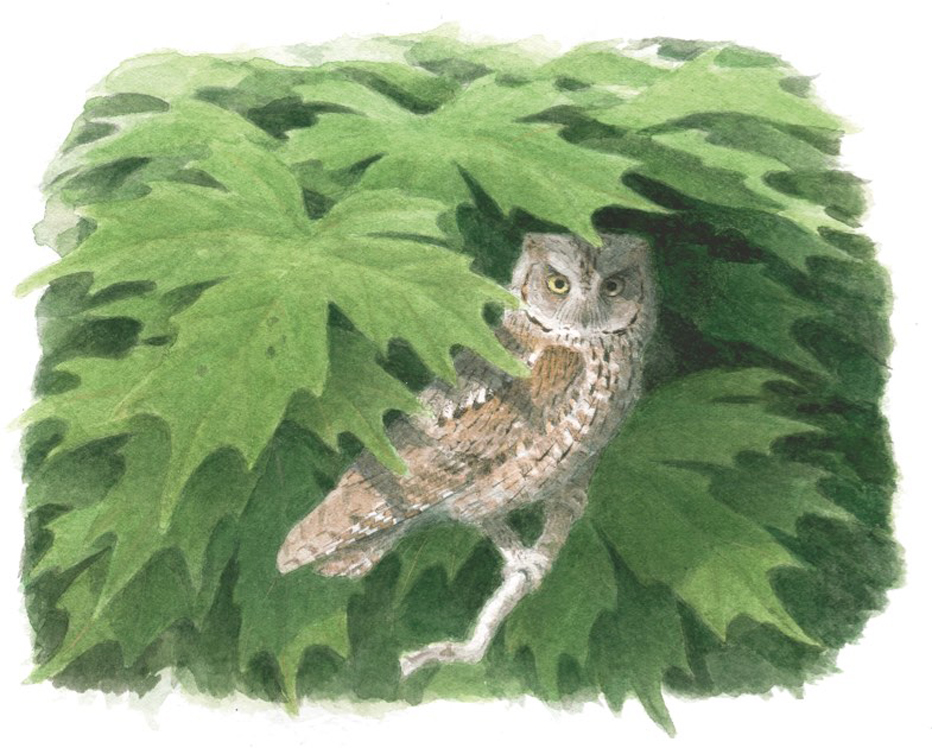
Håkan Delin
In CD2-13, several Eurasian Scops Owls are hooting in a wooded gorge in southern Kazakhstan. Two of them sing a musical E just like in the Algarve, and the third is only slightly lower-pitched. The two groups of males are over 6500 km apart, but the only difference I can hear is that the hoots in Kazakhstan sound slightly shorter. This is partly because the acoustics are drier; the more resonant Algarve valley makes the hoots seem longer than they really are, and the omnidirectional microphone I used in Portugal captures more reflections than the parabolic one I used in Kazakhstan.
CD2-13: Eurasian Scops Owl Otus scops Berkhara Gorge, Karatau mountains, Kazakhstan, 19:00, 13 May 2000. Hooting of three males. The nearest one has an intermittent and very faint second note or bip. Background: Eastern Nightingale Luscinia megarhynchos golzii. 00.028.MR.04010.02
Over much of Eurasian Scops Owl’s range, the Common Midwife Toad Alytes obstetricans produces a confusingly similar sound (CD2-14). The toad’s call is not only shorter but lacks any audible inflection in pitch, which in scops owls is usually easy to hear. In Spain and Portugal, Iberian Midwife Toad A cisternasii can sound even more similar to Eurasian Scops because its song-notes are slightly longer. Add a bit of resonance, and it can be really hard to tell a distant one from a Scops. With CD2-15, I was convinced that I was recording my first autumn scops owl, until I noticed that the rhythm was too irregular and the notes were a bit too flat.
CD2-14: Common Midwife Toad Alytes obstetricans Manteigas, Serra da Estrela, Portugal, 22:56, 18 July 2013. Song of two males in a cabbage patch. Background: other males, and a Tawny Owl Strix aluco. 130718.MR.225614.01
CD2-15: Iberian Midwife Toad Alytes cisternasii Rosmaninhal, Idanha-a-Nova, Portugal, 21:25, 24 September 2009. Song of a distant male. Background: rutting Red Deer Cervus elaphus and fish in the Tagus river. 090924.MR.212512.02
One important variant of Eurasian Scops Owl hooting seems to have gone almost unnoticed in the literature. Roughly two thirds of the way between each toot and the next, there is often a very quiet, short bip. To my ear, it precedes the main toot as a kind of ‘up-beat’. To illustrate it well, I have chosen an exceptionally clear example, this time a male from Portugal. His bips could be heard from a distance of 400 m, although I went much closer to make the recording. Normally the bip is only audible at very close range. It is also present in the recording from Kazakhstan (cf, CD2-16), where it is much harder to hear. Can you pick it out?
CD2-16: Eurasian Scops Owl Otus scops Rosmaninhal, Idanha-a-Nova, Portugal, 00:53, 13 May 2012. Hooting with prominent bip preceding main note. Background: Iberian Green Frog Pelophylax perezi, Common Nightingale Luscinia megarhynchos. 120513.MR.005304.01
Hooting with an additional bip occurs at a low incidence in all regions where Eurasian Scops Owl occurs, including Pakistan where Roberts & King (1986) showed it in a sonagram. In Cyprus Scops Owl O cyprius, bips are the rule and very audible. Oriental Scops Owl O sunia and its close relative the Socotra Scops Owl O socotranus also have one or more quiet, lower-pitched notes preceding the main hoot (Pons et al 2013), so these may be a throwback to a common ancestor. Their presence or absence in Eurasian Scops seems to be a matter of individual variation. Sometimes an individual gives just an occasional bip. Most individuals do not bip at all and amazingly, a 26-page study of individual variation in hooting (Dragonetti 2007) fails to mention it at all.
Individual male scops owls can often be identified by their hooting. König (1973) found that she could play back recordings in perfect synchrony with their performer, even when the recordings were several years old. Rate of delivery is the most reliable feature. The shape of the hoots and the average pitch of their sustained part are nearly as consistent (Dragonetti 2007, Galeotti & Sacchi 2001). A minority of males have two clearly different types of hoots in their repertoire (Dragonetti 2007). The way they alternate is by ‘eventual variation’, ie, AAABBB rather than ‘immediate variation’ or ABABAB. This can lead to overestimates of the number of males present in a given area.
Pitch matters to male Eurasian Scops Owls. The lower the hoot, the fatter the male (Hardouin et al 2007). Dimensions such as wing length are irrelevant; it is weight that counts. Fat reserves are a better indication of a male’s condition than his length or wingspan. Playback experiments have shown that males are able to vary the pitch of their hoots and ‘lie’ about their fitness. When played a recording of an unusually low-pitched male 20 out of 26 males responded by lowering the pitch of their own hoots (Hardouin et al 2007). Curiously, males tend to respond more vigorously to higher-pitched than to lower-pitched playback, suggesting that they exercise greater caution when reacting to heavy strangers. Males with lower-pitched hoots are the most successful breeders, even when their hoots are lower than expected from their body condition. This may be due to the advantage their low-pitched hoots give them when competing for the best territories (Hardouin et al 2009).
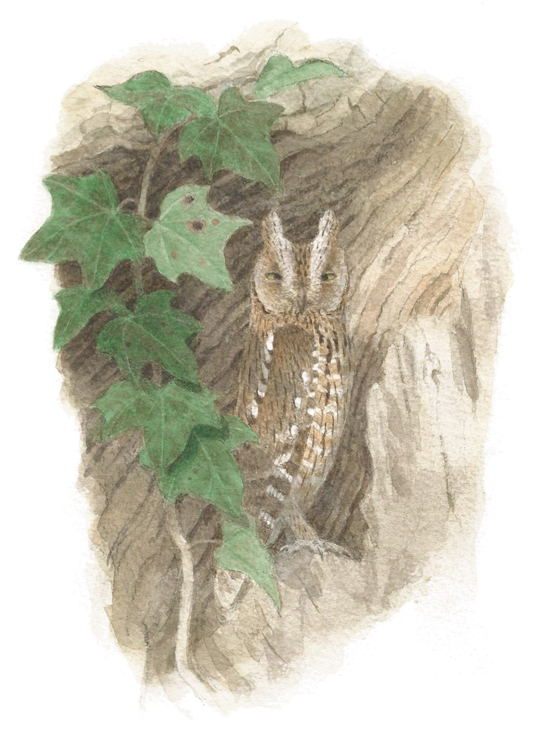
Håkan Delin
Eurasian Scops Owls are famous for their monotony. It can be difficult to avoid being hypnotised and keep track of what is going on. Sexing them is often far from straightforward, and may not always be possible. After the courtship period, however, females hoot very little. Often two Scops apparently hooting together are simply two males on different pitches. I made a breakthrough when I worked out that many hoot‑like sounds, especially in females, are actually something else. These twiu calls as I call them are equivalent to the soliciting calls of other owls: I hear them especially when the owls are exchanging food and copulating. In the three other Western Palearctic scops owls they are more obviously different from hooting and easier to recognise. But before I give examples of twiu calls, how do females sound when they really do hoot?
Paired females hoot with a more variable pitch than males, as well as sounding weaker or quieter, and sometimes slightly hoarse. When these characteristics are combined with a much higher overall pitch and they are perched close to a typical-sounding male, we can identify them with confidence (CD2-17). Paired females hooting at a more male-like pitch must be sexed more carefully by listening for as many clues as possible: they may eventually switch to a higher-pitched version. Unpaired females may not always be possible to sex with confidence (König 1973).
CD2-17: Eurasian Scops Owl Otus scops Northern slopes of Mt Etna, Castiglione, Catania, Sicily, 20:54, 21 April 2007. Hooting of a female, with a lower-pitched hoot from her mate at 0:20. There are also twiu calls towards the end of the recording. Background: Sicilian Partridge Alectoris whitakeri, Cucumiau Athene noctua and other Eurasian Scops Owls. 07.017.AB.04717.32
In late April 2007, Arnoud happened to be on Sicily when pair formation was at a peak. Many of the Eurasian Scops Owl recordings he made there were of a pair breeding in an abandoned orchard beside a lava field on the northern slopes of Mt Etna. In CD2-18, the male and female are both hooting. The female is the closer bird hooting at a high pitch, while the male gives a few lower-pitched hoots before falling silent. Then from 0:28 the female drops to a slightly lower pitch and utters a series of twiu notes that have an audibly different shape.
CD2-18: Eurasian Scops Owl Otus scops Northern slopes of Mt Etna, Castiglione, Catania, Sicily, 05:13, 22 April 2007. Hooting of female and male, followed by twiu soliciting calls of female. Background: Cucumiau Athene noctua and Common Nightingale Luscinia megarhynchos. 07.019.AB.02958.11
CD2-19 was recorded earlier in the night. It starts with the male giving his own lower-pitched version of the same twiu note, which he delivers more quickly than his hooting. At 0:34 the female arrives hooting, before giving her own twiu from 0:41- 0:46. When the male starts to hoot (with additional bip notes), she briefly reverts to her own high-pitched hooting. The sequence ends with copulation, accompanied by a shrill twitter from the male and a croaking, lower-pitched dr-r-r-r from the female.
CD2-19: Eurasian Scops Owl Otus scops Northern slopes of Mt Etna, Castiglione, Catania, Sicily, 21:17, 21 April 2007. Twiu soliciting calls of male and female, then hooting of both, leading to copulation at 0:58. Background: other Eurasian Scops Owls. 07.017.AB.05212.31
Once I recognised the copulation twitter, which is only ever given by the male, I started hearing it often, sometimes far into the breeding season. In CD2-20, the microphones were placed within two metres of a cavity in a Holm Oak that a pair appeared to be adopting as a nest (they ended up nesting elsewhere). The male of the nearby pair had two types of loud hoot, one of which was disyllabic. Surprisingly, the female often sounded lower-pitched than he, something that was not supposed to happen. The recording starts with the male hooting and the female giving a series of what I now know to be twiu calls. Another male is hooting some distance away (if you are listening on headphones, he should be on the right). At 0:29 the female flies right and lands heavily on a twig beside the microphone where she carries on giving her low-pitched twiu. At 0:51 the male’s wingbeats can be heard as he flies a short distance. The female flies to join him from 1:02. At 1:09 the copulation twitter is overlaid on one of the female’s twiu calls, and my sexing is confirmed.
CD2-20: Eurasian Scops Owl Otus scops Rosmaninhal, Idanha-a-Nova, Portugal, 03:29, 14 May 2012. Hooting of male, twiu calls of female, then copulation twitter of male. Background: Iberian Green Frog Pelophenax perezi. 120514.MR.032950.00
On another occasion, I ruined a recording of the lead-up to copulation by returning in my car at just the wrong moment. I had left the equipment running for two hours so I was very unlucky that the only action happened right then. Fortunately the climax occurred only after I had stopped the motor (CD2-21). I include it here to draw attention to the croaking call (König 1973), which sounds like an amphibian, perhaps a Common Frog Rana temporaria or a Natterjack Toad Bufo calamita. I am referring to the soft, low-pitched, croaking drrrr… drr.. that the female does at the end of the male’s copulation twitter (it was also present in CD2-19). This croaking call is similar in structure to the feeding calls of other owls, but the adults use it for more than just feeding. König (1973) heard them croaking both when offering and demanding favours, as well as when distributing food to the young.
CD2-21: Eurasian Scops Owl Otus scops Rosmaninhal, Idanha-a-Nova, Portugal, 00:01, 13 May 2012. Copulation, starting with hooting of male and twiu calls of female. Immediately after male’s copulation twitter, female gives croaking call. Background: Iberian Green Frog Pelophenax perezi. 120513.MR.000157.00
It was only by the skin of my teeth that I managed to record juvenile Eurasian Scops Owls for this book. Every time adult behaviour at night suggested the location of a nest, daytime searching revealed nothing. This went on for years. At Rosmaninhal in Portugal, I searched for nests in early June on an evening when the males were frustratingly quiet. Without hearing them I had no idea where they were. At one point my impatience got the better of me and I tried a little playback. Within seconds a scops owl hit me hard on the side of my head. I could feel the sharp claws, although they failed to draw blood. I never did find this male’s nest, and when I eventually found his neighbours’ nest it was through more patient fieldcraft.
I now realise that most of my efforts were simply too early. Scops owls time their breeding to coincide with the maximum abundance of large insects, and adults may be feeding fledglings long after most other owls have finished. Egg‑laying is from mid-May to mid-June. With an incubation period of about 24 days and the owlets being fed for up to 60 days (Mebs & Scherzinger 2004), late juveniles may only attain independence in the first half of September.
For two years, I made a big effort to find the nest of a particular pair near Rosmaninhal (cf, CD2-20 & CD2-21). In the second year, in 2013, I made a special trip in early June to try to find the nest, or at least to study the adults’ behaviour. The owls were copulating at least six times a night, so it seemed that egg laying was imminent. I tried climbing a few Holm Oaks where they had been, and peering into holes. All kinds of things were inside, Wood Mice Apodemus sylvaticus, Spotless Starlings Sturnus unicolor, even a latrine belonging to Common Genets Genetta genetta, but no scops owls. When I returned in the evening of 19 July, I finally heard juvenile begging calls coming at incredibly low volume from one of their four favourite trees. The calls were barely audible, even at about 10 m distance.
I placed the microphones close to the nest and left, recovering them in the morning. During the night, the parents fed the young frequently, often several times per hour. With the help of photographs in König (1973), I aged the young at about 15 and 17 days old. In CD2-22, one of the adults announces its arrival with two twiu-like calls. After a few seconds it goes to the nest, and the young start begging intensely with an almost puppy-like panting. The striking thing about these begging calls is the very fast rate of their delivery, up to around 70/minute. König (1973) found 30/minute to be typical of relaxed situations, rising to twice that rate when the young were being fed. From 0:21, the adult gives some croaks, used here as food-offering calls. One of the young gives a few very high chitters of discontent, eg, at 0:33 and 0:43.
CD2-22: Eurasian Scops Owl Otus scops Rosmaninhal, Idanha-a-Nova, Portugal, 22:20, 19 July 2013. Adult announces arrival with twiu-like calls, then croaks as a feeding call. Two nestlings beg and give occasional high-pitched chitters. Background: crickets and Iberian Green Frog Pelophenax perezi. 130719.MR.222054.21
Begging calls increase gradually in volume until the young leave the nest on around their 21st day. From then on, they rock their body when begging. This looks like an exaggeration of the way perched raptors use parallax, rocking their head from side to side when fixing the location of prey. From about the 30th day, the begging call takes on an increasingly voiced or tonal quality. Then from the 60th day, the gestures decrease. König’s (1973) sonagram of 124-day-old female shows a mostly tonal begging call that has almost evolved into a twiu call.
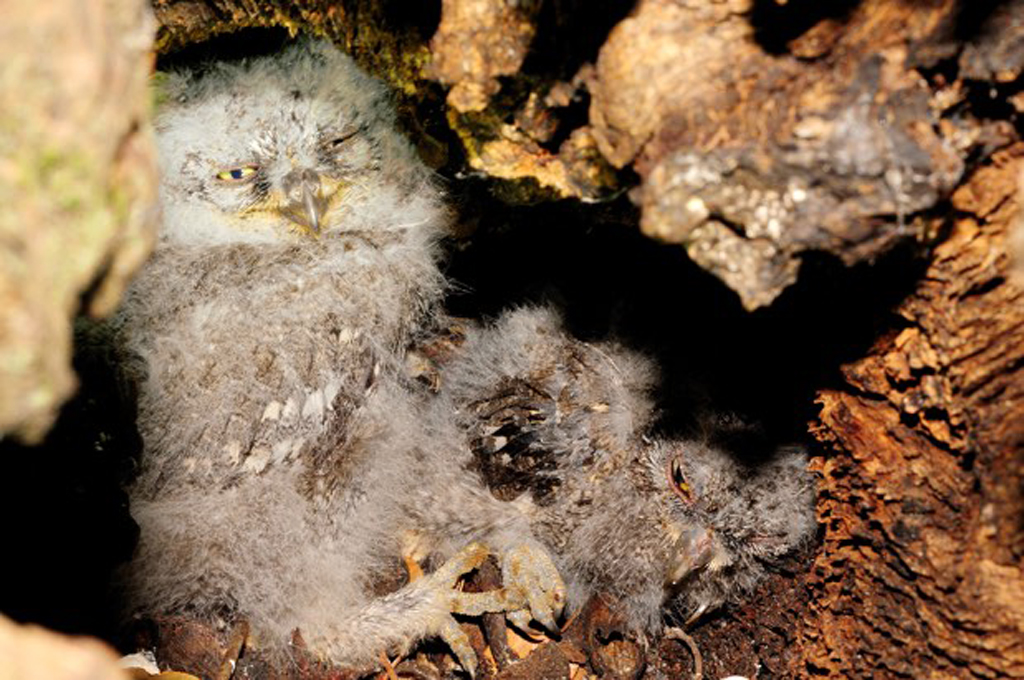
Eurasian Scops Owl Otus scops, nest with chicks, Rosmaninhal, Idanha-a-Nova, Portugal, 20 July 2013 (Paulo Monteiro). Same as in CD2-22.
Sadly, I never had the chance to follow the development of these young. A few days after my visit the nest was predated, and the juveniles’ delicate body feathers were scattered on leaf litter under the tree. Some had beak-shaped nips taken out of them, so I suspect the predator was a bird. Two is a very small brood size for Eurasian Scops Owl, so perhaps the predator had taken one or two young before I found them. In my recordings, two suspects emerge. An Azure-winged Magpie Cyanopica cooki called several times uncomfortably close to the nest during the night, and one of the adults got very excited when a Little Owl Athene vidalii appeared nearby.
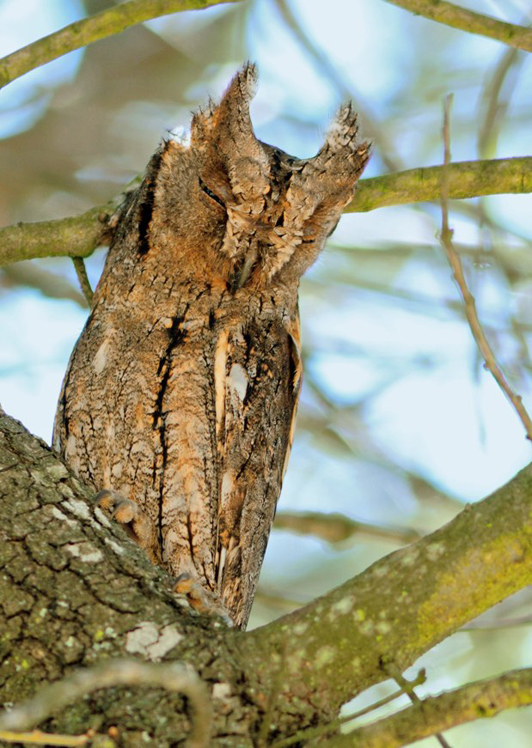
Eurasian Scops Owl Otus scops, Rosmaninhal, Idanha-a-Nova, Portugal, 20 July 2013 (Paulo Monteiro). Within 2 m of the nest in CD2-22.
One call of Eurasian Scops Owl actually sounds very similar to a Little Owl, so much so that it forms an identification pitfall. When we went through our database searching for any recordings of Little Owl and Cucumiaus A noctua from strange places, we found a couple that were really Scops giving excitement calls. Although we may hear these at any point from spring to at least autumn, I have heard them most often after the young leave the nest. CD2-23 and CD2-24 date from this period. While recording them, I nearly made what would have been an embarrassing mistake. I knew that the excitement calls were coming from an adult Scops, but I could also hear a juvenile owl in the same valley. Its calls seemed too loud and were repeated with gaps too long to be juvenile Scops. With the adult alarming nearby, however, I started to wonder if my assumptions about Scops begging calls were correct. The juvenile was in fact a Eurasian Eagle-Owl. No wonder the adult Scops was getting so excited!
CD2-23: Eurasian Scops Owl Otus scops Vale da Ribeira das Mercês, São Bras de Alportel, Portugal, 22:47, 13 August 2011. Varied excitement calls of an adult. Background: juvenile Eurasian Eagle-Owl Bubo bubo at 0:35 and 0:44. 110813.MR.224710.11
CD2-24: Eurasian Scops Owl Otus scops Vale da Ribeira das Mercês, São Bras de Alportel, Portugal, 22:51, 13 August 2011. Excitement calls, including a whinnying variant. Background: feral pigs. 110813.MR.225126.11
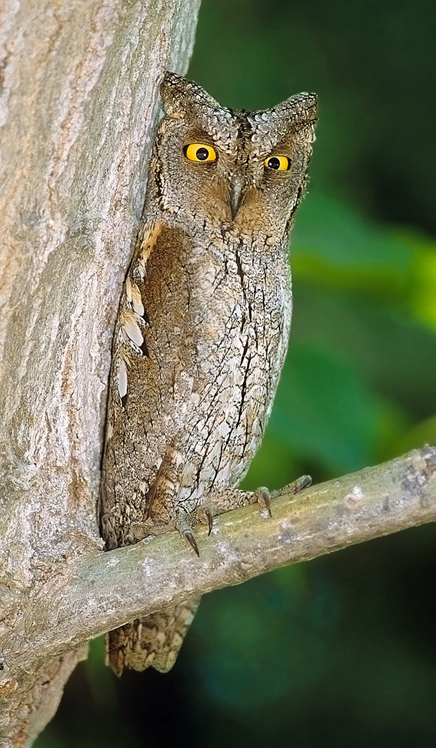
Eurasian Scops Owl Otus scops, Lesvos, Greece, 26 April 2001 (René Pop)
In areas such as southern Spain (König 1970) and Crete (Streseman 1943) where Eurasian Scops Owls are resident, they sometimes hoot in autumn and winter. I myself once heard several in the Ebro Delta, Catalonia, in late September. Males are said to hoot occasionally during autumn migration (Mebs & Scherzinger 2004), although this seems to be rare. At Sagres in the extreme south-western corner of Europe, where migration has been monitored extensively by teams of observers since 1990, Scops are present each autumn but Ricardo Tomé, one of the project coordinators, tells me that none have ever been heard calling. Only one of my friends in Portugal has heard a scops owl in autumn at a site where they do not breed (Georg Schreier pers comm).
Eurasian Scops Owls wintering in Africa call very little during their stay (Moreau 1972, Cramp 1985), and this combined with their visual similarity to African Scops Owl O senegalensis makes them very difficult to study. We still know very little about the half of their life spent outside Europe, and I wonder what some well-designed tracking experiments might reveal. When Mori et al (2014) did a winter survey in Italy, they found that the few Eurasian Scops wintering there respond more strongly to playback of Cucumiau than they do to Eurasian Scops.
During northward migration, Eurasian Scops Owls can be surprisingly vocal. Andrea Corso told me about orchards along the Sicilian coast where, if you imitate one on the right day in spring, you receive many replies but a few weeks later there are none. In mid-April, I once heard hooting at dawn, coming from thick tamarisk scrub on Fuerteventura in the Canary Islands, where no Scops Owls breed. In Portugal, I have sometimes heard hooting during a single spring night in places where I never heard one before or after.
Spring is also the time when the great majority of vagrant Scops Owls overshoot into northern Europe. In Britain and Ireland, there were 96 records up to the end of 2012 (rarebirdalert.co.uk). April, May and June have an almost equal share of the total. Many were shot during the 19th century, when there were even three records involving more than one individual. Older distribution maps (eg, in Mikkola 1983) show the species breeding further north than it does today, especially in France and Russia, so overshooting was probably commoner back then. In recent decades agriculture has intensified so much that large insects have become scarce. Insecticides have certainly contributed, but so has the disappearance of suitable habitats. In Portugal, for example, most olive oil is now produced in intensively managed plantations with much reduced insect life and trees too young to have holes.
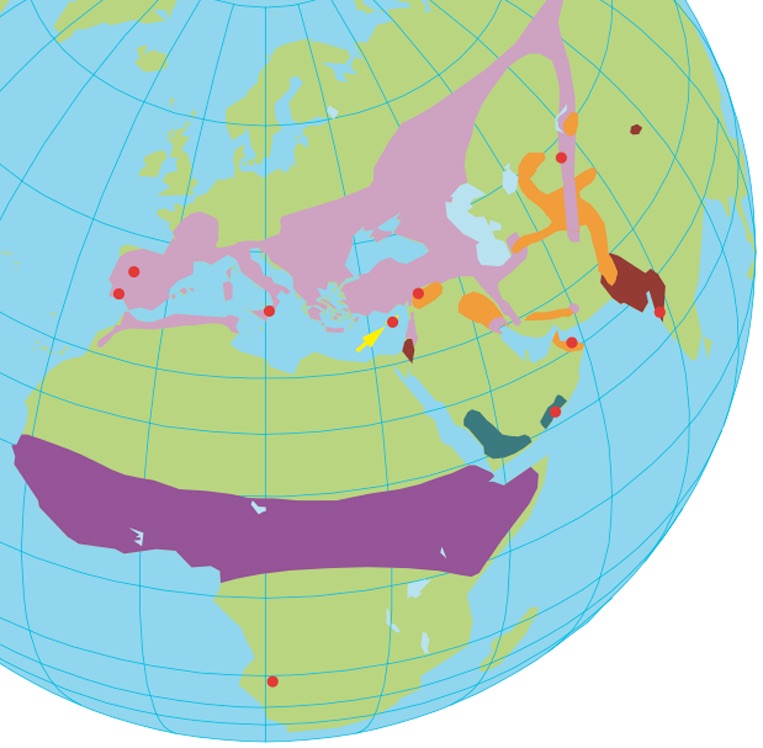
Approximate breeding and winter distribution of Eurasian Scops Owl Otus scops (pink and purple) and Pallid Scops Owl O brucei (orange and brown ) and breeding distribution of Cyprus Scops Owl O cyprius yellow (Cyprus only) and Arabian Scops Owl O pamelae green . Recording locations of Eurasian, Cyprus, Pallid, Arabian, Oriental Scops Owl O sunia and African Scops Owl O senegalensis indicated by red dots.
Nightingales and “little crows”
Text by Stephen Menzie
I’d been in central Spain for several days trying to record Dartford Warblers Sylvia undata – between strong winds, rain, and unseasonably cold temperatures, I hadn’t managed to get very far with that task. Every evening, despite the wind, up to seven Common Nightingales would begin singing in the poplar belt at the edge of the village where I was staying. They’d continue until after sunset, by which time up to three Eurasian Scops Owls Otus scops had started up as well. After a little while, though, the nightingales would fall silent and the next few hours of the night were left to the owls.
Speak to the locals about the scops owls and you’ll hear two conflicting stories. For as long as anyone can remember, the local name for scops owl has been “little crow”. Passed down through the generations, it was local belief that the toot noises they were hearing at night came from roosting crows. My friend, Marcel Gil Velasco, whose family hails from the village, had explained to his relatives that the sound was in fact coming from an owl and not a crow; but sometimes folk-law is more persistent than rationale and the belief that the sound was coming from a crow continued. Then, one summer, there was unease amongst the villagers. Several snakes had been heard at night, high up in the trees on the edge of the village. The sound they were making? Yes, you guessed it: a short, plaintive toot. The fact that the year before, and for every year in living memory, this sound had been assigned to corvids seemed to make little difference. This year, the sound was coming from snakes, and no amount of explanation would persuade the locals otherwise. Winters in this part of Spain can be long and cold – sufficiently long that, by the time the scops owls had returned again the following spring, some villagers had forgotten about their serpentine worries of the previous year and the nocturnal sounds were, once again, attributed to the “little crow”. For others, though, worries still remained, and tales of having seen snakes make this noise started to emerge. The result: an enduring debate within the village as to what the sound is – a snake, or a crow? The one thing it definitely isn’t, if you ask any of the residents, is an owl!
One night, up late with a bottle of Rioja, I was able to hear the second night-time change-over: as the almost-full moon rose in the sky, the “little crows” became increasingly less vocal and the chorus of nightingales got going again. The weather outside had become surprisingly benign – the temperature was such than a coat wasn’t required (the only time that weekend), the rain had stopped, and the wind was all-but-gone.
Read more about the Common Nightingales here.
